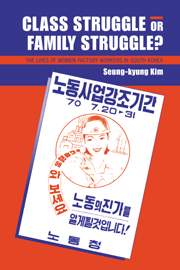Book contents
- Frontmatter
- Contents
- List of Tables and Figures
- Preface: Field, Subject, Author
- Acknowledgments
- Language Note
- 1 Women Caught between Global Capitalism and South Korean Patriarchy
- 2 The Process of Production in the Masan Free Export Zone
- 3 The Myth of Social Mobility: Its Creation and Reproduction among Women Workers
- 4 Labor Militancy and Collective Action
- 5 The Making of Working-Class Identity: Students' Theories and Workers' Lives
- 6 Conclusion
- References
- Index
4 - Labor Militancy and Collective Action
Published online by Cambridge University Press: 02 December 2009
- Frontmatter
- Contents
- List of Tables and Figures
- Preface: Field, Subject, Author
- Acknowledgments
- Language Note
- 1 Women Caught between Global Capitalism and South Korean Patriarchy
- 2 The Process of Production in the Masan Free Export Zone
- 3 The Myth of Social Mobility: Its Creation and Reproduction among Women Workers
- 4 Labor Militancy and Collective Action
- 5 The Making of Working-Class Identity: Students' Theories and Workers' Lives
- 6 Conclusion
- References
- Index
Summary
Although most working-class women struggled with adverse circumstances alone, others wanted to do something not just for themselves, but also for their fellow workers who were experiencing similar or even worse hardships. These women gravitated toward the labor movement. The Korean labor movement's struggle toward a more just society has a long history and includes many episodes with close parallels to the situation in MAFEZ. Foreign capitalists have been exploiting poorly paid Korean workers since the introduction of the wage labor system, and nationalism has been an important component of workers' resistance. Interested workers could learn the details of this history in classes taught by labor activists (see the following discussion). This chapter considers this history and how it shaped the way the labor struggle manifested itself in Masan.
NATIONALISM, COMMUNISM AND LABOR IN KOREAN POLITICS
The Korean labor movement began with the introduction of wage labor to the port cities during the closing years of the nineteenth century (Kim Kŭm-su 1986:23). During the Japanese colonial occupation, 1910–1945, the labor movement became closely connected with the struggle for independence (Han'guk Minjungsa Yŏn'guhoe 198611:181–188; Kim Yun-hwan 1982:343). Thus, from the earliest times, labor organizations in Korea have combined political and economic goals (Cho Sŭng-hyŏk 1984:121).
As the country underwent rapid industrialization under Japanese colonial rule, the importance of the organized labor movement increased, and a sometimes violent struggle ensued between workers and Japanese and local capitalists backed by the colonial government. Extreme repression by the colonial government radicalized the labor movement (Kim Yun-hwan 1982:342), forcing it to become “an underground movement with closer ties to the communist movement” (Koo 1993:134).
- Type
- Chapter
- Information
- Class Struggle or Family Struggle?The Lives of Women Factory Workers in South Korea, pp. 97 - 128Publisher: Cambridge University PressPrint publication year: 1997



